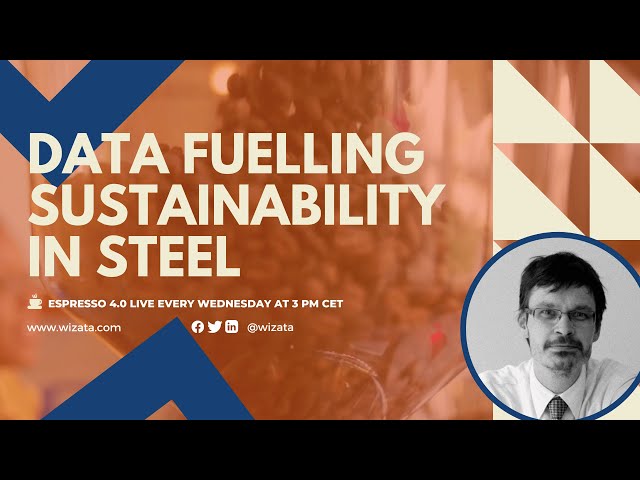![]() Espresso 4.0 by
Espresso 4.0 by
Wizata
My name is Philip. I'm a mechanical engineer by education. I did a Ph.D. in Engineering sciences in Gantt University in Belgium and also a master in the ocean and offshore technology at Cranfield University. And I've spent the better part of the last 15 years with the ArcelorMittal Group, the world's biggest steel supplier.
Starting this year, I joined Fenendus, an investment company, as a joint venture between ArcelorMittal and the Flemish region.
You have a plethora of experience in the matter of sustainability and steel manufacturing. And that's why we have why I wanted you to be part of the show of one of the guests in one of the episodes.
Role of digital solutions in sustainability
And let's get right into it. In your opinion and experience, my question is, what role do digital solutions play in reaching sustainability goals in the steel manufacturing industry?
I believe they are the bread and butter for it because we tend to say what gets measured gets done. And we're looking at an unprecedented challenge in front of us in decarbonizing the steel industry.
We at ArcelorMittal and most of our peers or the entire European steel industry still largely follow the blast furnace route, which produces one ton of steel at the expense of two tons of CO2, or almost two tons of CO2. This starts jeopardizing our very license to operate.
Hence we now have a significant investment program in front of us where we will gradually step away from the blast furnace route and go towards another technology, DRI, which is direct reduced iron with an electric arc furnace, and that will significantly reduce our carbon footprint.
To answer your question, to quantify that and understand whether we're on the good track, we will need digitization of our assets from the upstream steel-making down to even the packaging, the shipping, and the logistics. It will be the tiny gears in this entire process that will actually inform the decisions that we need to take moving forward.
The value of data
What is the value of data or measurements, as you call them, in deploying a digital solution for more sustainable production? Can you expand on that? How important is it to have data from Ore all the way to the finished product?
I'd be happy to because, as I said in the introduction, I studied pipeline engineering at Cranfield. So I tend to say I'm a mechanical engineer by education and a pipeline engineer by religion. I was exposed to the oil and gas industry in the early days of my career, and I am wholeheartedly convinced that data will be the new oil at face value.
So we can appreciate data as a reservoir of potential energy that can unlock tremendous value, provided you know where and when, and how to unlock and drill for that data. And that you have the tools, the instruments to refine and distill that data into valuable and actionable insights.
And hence this is the value I see for the steel industry, but also the petrochemical industry and all the hard-to-abate industries; it's going to be the data that will point us in the direction where we need to go to reduce our footprint, to converge into a more sustainable and circular economy and ultimately build a more sustainable future.
How to take the first step toward sustainability?
I'm head of a plant. How do I start a project like this? What key principles do I need to keep in mind for a successful project?
I would do a Pareto Analysis to understand where the pressing pain is. We have a lot of data, measurements, and variables in the process. Those can be the temperature of a reheating furnace, forces of a rolling mill, or reduction you need to obtain the steel's properties - the steel mill is a living beast.
It's a living animal which is also requiring vast amounts of energy. Energy saving is a concern across the board, not only for the steel industry but for our colleagues operating blast furnaces, electric arc furnaces, annealing furnaces, and the like.
Suppose we can save just a couple percent of the energy that already makes a tremendous difference. So, that’s where I would start. I would identify one of those assets that consume a lot of energy, such as an Annealing furnace.
Launch a pilot on that asset with someone well-versed in data analytics and my team of process engineers and data scientists to define a KPI. Can I reduce the energy consumption or the emission, or what have you, of this particular asset to reach this target and then implement a pilot and see to what extent we can improve the process?
A vital part of launching such a project is the people on the ground business experts need to be involved with. Whether it's an internal team of data scientists or an external supplier, every site, manufacturing process, and asset is different.
There are no two that are equal, although there are a lot of commonalities. People on the ground, with years of experience, will know best. Their involvement is key in development as well as in later adoption.
AI Ethics and the future
A less serious question - if I were to call you on a Sunday at 02:00 P.m., what would I be interrupting you in?
Likely, I’d be reading a book. I'm in the process of reading up on artificial intelligence. So I read a couple of books. I'm currently reading AI ethics, which looks at the philosophy and ethics of artificial intelligence, bias in data, and whether artificial intelligence can explain its decisions. And I must say, for an engineer, it makes revealing reading.
What is the coolest thing you recently saw or witnessed? Whether it's Industry 4.0 or any technological advancement or innovation?
The coolest thing I recently saw was optimizing a pipeline network informed by remote sensing. It was both the throughput and the temperature of a pipeline network conveying industrial gasses that was optimized by a network of distributed sensors and data analysis and some big data mining or artificial intelligence to improve and optimize.
This tells me that this is no longer something that may unfold in the future, but it's already technology that is happening today in front of us.



